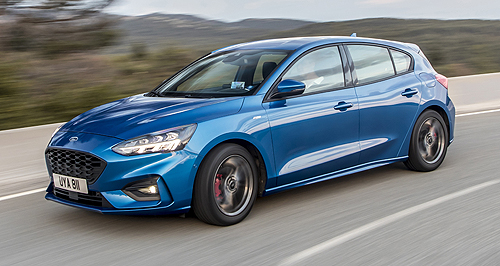Future models - Ford - FocusFirst drive: Safe all-new Ford Focus soarsFord has thrown everything into its VW Golf rivalling new-generation Focus26 Jul 2018 By BYRON MATHIOUDAKIS in FRANCE FORD claims that its upcoming Focus small car, due in Australia in November, is not only the best iteration in the 20-year history of the series, but also the best vehicle the company has ever produced.
Strong words from the Blue Oval, especially considering that the completely redesigned and re-engineered Focus brings with it a torsion beam rear suspension system on lower-line variants such as the expected best-selling Trend – a controversial move given the first-generation original pioneered a multi-link independent set-up in this class.
But that’s the point of the claim, made not coincidentally by the chief engineer of the all-new C2 architecture that cradles the latest Focus as well as a whole slew of future passenger cars and SUVs, Volkswagen Group MQB platform-style.
Ford says it has perfected its German small car to the point where – whether fitted with the optional independent rear end or not – the Volkswagen Golf rival is in rude health and at the top of its game.
Let’s see about that.
Literally underpinning such confidence is the freshness of the car. Everything bar a few nuts and bolts is different, from the body and interior to the steering, suspension and powertrains. Dubbed SA-series for Australia, the Focus is wider, lower, lighter (by about 88kg), stronger and quieter but no longer than its troubled immediate predecessor.
Key points to keep in mind is that the wheelbase grows 53mm, the structure is 20 per cent more torsionally rigid than before, the suspension attachment point-rigidity rises by up to 50 per cent, and there’s now 30 per cent boron steel incorporated.
Rubber bushes separate the IRS subframe for increased quietness and smoothness, adaptive dampers are available and the wagon has its own independent suspension set-up designed to maximise load space.
There’s a jacked-up (by 30mm) Active variant created to chase Subaru’s XV, the old Sport gives way to ST-Line with a 10mm lower ride height and unique suspension tuning, and the Focus is at the apex of driver-assist safety tech as well as connectivity for the class right now. No stone has been left unturned.
Deftly designed by a young Melburnian in Germany, the fourth-generation hatch looks contemporary and well-proportioned on one hand, but utterly safe on the other – the antithesis of the ’98 original.
Every inch seems designed to lure in Kia Cerato and Mazda3 buyers. The most aero small car this side of the latest Mercedes A-Class, the Ford’s cleaner lines, deeper side glass and no extra window pane aft of the now-longer rear doors are the headline visual changes.
The latter is an important move, because while it is yet another step away from the bold angular geometric lines of the earlier iterations, the result makes entry and egress easier for rear-seat occupants, within a longer wheelbase and on a floor that’s lower than before.
Thus, the feeling of space is palpable, with generous levels for legs, knees and shoulders. Ford says this generation was designed ‘from the inside out’ and it shows.
During the media briefing we learned that the Focus’ dash is a confluence of two competing designs, and for the most part it’s a success, at last ditching the encroaching bulky button-fest of the previous generation.
However, has Ford gone too far in terms of simplicity yet not far enough boldness wise?
While pleasant enough, well put together (in these pre-production examples), easy to operate and totally functional, the fascia’s aesthetics seem more suited to a Fiesta, with insufficient flair or sophistication for a Golf rival.
That’s undermined by no form of digitised instrumentation and multimedia cluster as per Audi’s Virtual Cockpit, along with a rudimentary Perspex-like head-up display panel when many are moving to windscreen-reflection systems. It’s as if the Focus’s dash has only caught up with the 2014 Mazda3’s. Also, the lower-level plastics have a cheap plasticky sheen to them. One giant step forward for Ford, a misstep for small-car kind.
That’s a pity because the ergonomics seem first class, with a quality feel to their operation. The front seats proved appropriately cosseting and supportive after many hours in them, all-round vision is better than Focuses have been for years, there is no shortage of storage areas and the Sync3 multimedia system remains one of the better varieties on the market.
Plus, the rear seat’s shape and positioning is clearly tailored towards adults. Too bad there are no face-level air vents back there, though.
And then there’s the cabin’s quietness – the upshot of class-leading aerodynamics – seemed remarkable after driving two up-spec IRS-enhanced hatches (the not-for-Oz Vignale range-topper and sporty ST-Line) on the southern French highways and B-roads last week, with impressively muted tyre and road roar. Only the rustle of wind around the door mirrors could be heard, and that only was at speeds above 130km/h. The Golf may have lost its refinement crown.
Just as encouragingly, the move to a downsized 134kW/240Nm 1.5-litre three-cylinder turbo-petrol engine does nothing to dilute the Ford’s new-found finesse.
Paired to an all-new eight-speed conventional auto, step-off acceleration is robust, backed up by fast and smooth changes, revealing a set of ratios well-matched to the hearty reserves of torque on tap. It’s also eager to respond when flooring the throttle, accompanied by a subdued hum that’s quite in keeping with the lively nature of this excellent little powertrain.
Better still is the six-speed manual in the ST-Line alternative, offering both a willingness to rev beyond the 6500rpm red line and a short, crisp action that makes the most of the available power. We can’t wait to drive this version on Australian roads.
While both vehicles wore 215/50R17 tyres, the Vignale also gained Focus-first adaptive dampers, but while they do provide a selectable array of softness and firmness, they also seem unnecessary compared to the remarkably supple yet controlled ST-Line with IRS.
Backed up by beautifully weighted electric steering, both hatches display a fluid linearity that makes cornering these cars fast a joy. Feel and feedback are first class, for an interactive and confidence-inspiring connection between car and driver that is probably better than anything else on the market in this segment right now. Traditional Focus fans can relax.
Except, it appears Australian-bound ST-Line hatches will instead opt for the cheaper torsion beam arrangement, which to us seems like internal sabotage in a series whose reputation is built on dynamic superiority.
Whether this annuls all the advances of the IRS set-up sampled on the Euro launch remains to be seen. We sure hope Ford Australia comes to its senses and fits our cars with the multi-link rear suspension that the rest of the world’s ST-Lines enjoy.
We did sneak out a brief spin in the only torsion-beam equipped Focus at the launch, a 1.5-litre four-cylinder diesel-powered Titanium hatch auto, and that too displayed very similar levels of steering and handling prowess over the mainly smooth launch roads.
However, there was a clear difference in the firmness of the springs, lacking the suppleness of most past Focuses, though that could have been down to the heavier front-end as a result of being a diesel. We’re not getting that or any other oil burner in Australia (for the time being, anyway), so we’re back at the start as far as how the torsion beam axle ultimately behaves.
So, it’s clear all stops were pulled in making the latest Focus (in Vignale and ST-Line hatchback guises anyway) a front runner in its fiercely contested small-car class. And class is the operative word, from the elegant if slightly anodyne styling to comfort and refinement levels that – in the IRS cars at least – should keep Volkswagen, Peugeot and Mercedes engineers up at night.
Focus has indeed matured to be one of the most formidable Fords yet, and it is Ford Australia’s best chance at finally having a hit in the small-car class. We only hope locally-bound cars have the better suspension and specification required to put it on top.  Read more25th of July 2018  Hybrid but no full EV for Ford FocusNew Focus to go mild hybrid in 2020 as Ford keeps EV for secret new model line25th of July 2018  Ford Focus platform to spawn multiple modelsSimilar to VW’s MQB set-up, Ford Focus platform will underpin passenger cars, SUVs24th of July 2018  Why most Ford Focus models ditch IRSOnly reputation kept torsion beam from taking over completely in new Ford Focus23rd of July 2018  Ford Focus Active set to take on Subaru XVJacked-up Focus Active hatch, but not wagon, likely but still unconfirmed for AusFocus pricing
Motor industry news |
Click to shareFord modelsResearch Ford Focus pricing
Motor industry news |
















Facebook Twitter Instagram